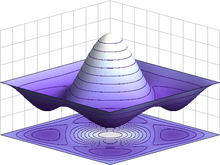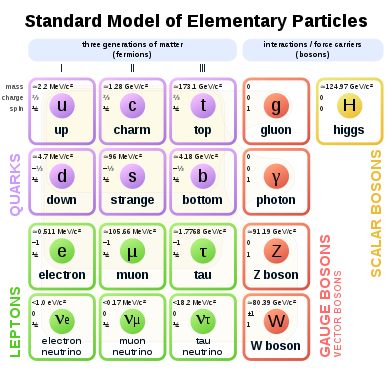Boson
In quantum mechanics, a boson (/ˈboʊsɒn/,[1] /ˈboʊzɒn/[2]) is a particle that follows Bose–Einstein statistics. Bosons make up one of two classes of elementary particles, the other being fermions.[3] The name boson was coined by Paul Dirac[4][5] to commemorate the contribution of Satyendra Nath Bose, an Indian physicist and professor of physics at University of Calcutta and at University of Dhaka[6][7] in developing, with Albert Einstein, Bose–Einstein statistics—which theorizes the characteristics of elementary particles.[8]

Examples of bosons are fundamental particles such as photons, gluons, and W and Z bosons (the four force-carrying gauge bosons of the Standard Model), the recently discovered Higgs boson, and the hypothetical graviton of quantum gravity. Some composite particles are also bosons, such as mesons and stable nuclei of even mass number such as deuterium (with one proton and one neutron, atomic mass number = 2), helium-4, and lead-208;[lower-alpha 1] as well as some quasiparticles (e.g. Cooper pairs, plasmons, and phonons).[9]:130
An important characteristic of bosons is that there is no restriction on the number of them that occupy the same quantum state. This property is exemplified by helium-4 when it is cooled to become a superfluid.[10] Unlike bosons, two identical fermions cannot occupy the same quantum state. Whereas the elementary particles that make up matter (i.e. leptons and quarks) are fermions, the elementary bosons are force carriers that function as the 'glue' holding matter together.[11] This property holds for all particles with integer spin (s = 0, 1, 2, etc.) as a consequence of the spin–statistics theorem. When a gas of Bose particles is cooled down to temperatures very close to absolute zero, then the kinetic energy of the particles decreases to a negligible amount, and they condense into the lowest energy level state. This state is called a Bose–Einstein condensate. This property is also the explanation for superfluidity.
Types
Bosons may be either elementary, like photons, or composite, like mesons.
While most bosons are composite particles, in the Standard Model of Particle Physics there are five bosons which are elementary:
- the Standard Model requires (at least) one scalar boson (spin=0)
- the four vector bosons (spin=1) that are the gauge bosons for the Standard Model:
γ
Photon
g
Gluons (eight different types)
Z
Neutral weak boson
W±
Charged weak bosons (two types)
There may be a sixth tensor boson (spin=2), the graviton (G), that would be the force-carrier for gravity. It remains a hypothetical elementary particle since all attempts so far to incorporate gravitation into the Standard Model have failed. If the graviton does exist, it must be a boson, and could conceivably be a gauge boson.[lower-alpha 2]
Composite bosons, such as helium-4 atoms, are important in superfluidity and other applications of Bose–Einstein condensates.
Properties

Bosons differ from fermions, which obey Fermi–Dirac statistics. Two or more identical fermions cannot occupy the same quantum state (see Pauli exclusion principle), and they are sometimes said to be the constituents of ordinary "rigid" matter. Unlike those, instances of a boson have no quantum-mechanical obstruction to occupy the same state. Bosons are often (although not necessarily) force carrier particles, including composite bosons such as mesons. Force carriers are also said to be the particles that transmit interactions, or the constituents of radiation.
The Bose–Einstein statistics imply that, when one swaps two bosons (of the same species), the wavefunction of the system is unchanged.[12] The quantum fields of bosons are bosonic fields, obeying canonical commutation relations.
The properties of lasers and masers, superfluid helium-4 and Bose–Einstein condensates are all consequences of statistics of bosons. Another result is that the spectrum of a photon gas in thermal equilibrium is a Planck spectrum, one example of which is black-body radiation; another is the thermal radiation of the opaque early Universe seen today as microwave background radiation. Interactions between elementary particles are called fundamental interactions. The fundamental interactions of virtual bosons with real particles result in all forces we know.
All known elementary and composite particles are bosons or fermions, depending on their spin: Particles with half-integer spin are fermions; particles with integer spin are bosons. In the framework of nonrelativistic quantum mechanics, this is a purely empirical observation. In relativistic quantum field theory, the spin–statistics theorem shows that half-integer spin particles cannot be bosons and integer spin particles cannot be fermions.[13]
In large systems, the difference between bosonic and fermionic statistics is only apparent at large densities — when their wave functions overlap. At low densities, both types of statistics are well approximated by Maxwell–Boltzmann statistics, which is described by classical mechanics.
Elementary bosons
| Standard Model of particle physics |
|---|
 |
|
Scientists Rutherford · Thomson · Chadwick · Bose · Sudarshan · Koshiba · Davis Jr. · Anderson · Fermi · Dirac · Feynman · Rubbia · Gell-Mann · Kendall · Taylor · Friedman · Powell · P. W. Anderson · Glashow · Iliopoulos · Maiani · Meer · Cowan · Nambu · Chamberlain · Cabibbo · Schwartz · Perl · Majorana · Weinberg · Lee · Ward · Salam · Kobayashi · Maskawa · Yang · Yukawa · 't Hooft · Veltman · Gross · Politzer · Wilczek · Cronin · Fitch · Vleck · Higgs · Englert · Brout · Hagen · Guralnik · Kibble · Ting · Richter |
All observed elementary particles are either fermions or bosons. The observed elementary bosons are all gauge bosons: photons, W and Z bosons, gluons, except the Higgs boson which is a scalar boson.
- Photons are the force carriers of the electromagnetic field.
- W and Z bosons are the force carriers which mediate the weak force.
- Gluons are the fundamental force carriers underlying the strong force.
- Higgs bosons give W and Z bosons (and other particles) mass via the Higgs mechanism. Their existence was confirmed by CERN on 14 March 2013.
Finally, many approaches to quantum gravity postulate a force carrier for gravity, the graviton, which is a boson of spin plus or minus two.
Composite bosons
Composite particles (such as hadrons, nuclei, and atoms) can be bosons or fermions depending on their constituents. More precisely, because of the relation between spin and statistics, a particle containing an even number of fermions is a boson, since it has integer spin.
Examples include the following:
- Any meson, since mesons contain one quark and one antiquark.
- The nucleus of a carbon-12 atom, which contains 6 protons and 6 neutrons.
- The helium-4 atom, consisting of 2 protons, 2 neutrons and 2 electrons; Also the tritium atom, consisting of 1 proton, 2 neutrons and 1 electron.
- The nucleus of deuterium, known as a deuteron, and its anti-particle.
The number of bosons within a composite particle made up of simple particles bound with a potential has no effect on whether it is a boson or a fermion.
Quantum states
Bose–Einstein statistics encourages identical bosons to crowd into one quantum state, but not any state is necessarily convenient for it. Aside of statistics, bosons can interact – for example, helium-4 atoms are repulsed by intermolecular force on a very close approach, and if one hypothesizes their condensation in a spatially-localized state, then gains from the statistics cannot overcome a prohibitive force potential. A spatially-delocalized state (i.e. with low |ψ(x)|) is preferable: if the number density of the condensate is about the same as in ordinary liquid or solid state, then the repulsive potential for the N-particle condensate in such state can be no higher than for a liquid or a crystalline lattice of the same N particles described without quantum statistics. Thus, Bose–Einstein statistics for a material particle is not a mechanism to bypass physical restrictions on the density of the corresponding substance, and superfluid liquid helium has a density comparable to the density of ordinary liquid matter. Spatially-delocalized states also permit for a low momentum according to the uncertainty principle, hence for low kinetic energy; this is why superfluidity and superconductivity are usually observed in low temperatures.
Photons do not interact with themselves and hence do not experience this difference in states where to crowd (see squeezed coherent state).
See also
- Anyon – Type of particle that occurs only in two-dimensional systems
- Bose gas – State of matter of many bosons
- Parastatistics – Notion in statistical mechanics
Notes
- Even-mass-number nuclides, which comprise 153/254 = ~ 60% of all stable nuclides, are bosons, i.e. they have integer spin. Almost all (148 of the 153) are even-proton, even-neutron (EE) nuclides, which necessarily have spin 0 because of pairing. The remaining 5 stable bosonic nuclides are odd-proton, odd-neutron stable nuclides (see even and odd atomic nuclei#Odd proton, odd neutron); these odd–odd bosons are: 2
1H
, 6
3Li
,10
5B
, 14
7N
and 180m
73Ta
). All have nonzero integer spin. - Despite being the carrier of the gravitational force which interacts with mass, the graviton is expected to have no mass.
References
- Wells, John C. (1990). Longman pronunciation dictionary. Harlow, England: Longman. ISBN 978-0582053830. entry "Boson"
- "boson". Collins Dictionary.
- Carroll, Sean (2007). Guidebook. Dark Matter, Dark Energy: The dark side of the universe. The Teaching Company. Part 2, p. 43. ISBN 978-1598033502.
... boson: A force-carrying particle, as opposed to a matter particle (fermion). Bosons can be piled on top of each other without limit. Examples are photons, gluons, gravitons, weak bosons, and the Higgs boson. The spin of a boson is always an integer: 0, 1, 2, and so on ...
- Notes on Dirac's lecture Developments in Atomic Theory at Le Palais de la Découverte, 6 December 1945. UKNATARCHI Dirac Papers. BW83/2/257889.
- Farmelo, Graham (25 August 2009). The Strangest Man: The Hidden Life of Paul Dirac, Mystic of the Atom. Basic Books. p. 331. ISBN 9780465019922.
- Daigle, Katy (10 July 2012). "India: Enough about Higgs, let's discuss the boson". AP News. Retrieved 10 July 2012.
- Bal, Hartosh Singh (19 September 2012). "The Bose in the Boson". The New York Times blog. Archived from the original on 22 September 2012. Retrieved 21 September 2012.
- "Higgs boson: The poetry of subatomic particles". BBC News. 4 July 2012. Retrieved 6 July 2012.
- Poole, Charles P. Jr. (11 March 2004). Encyclopedic Dictionary of Condensed Matter Physics. Academic Press. ISBN 978-0-08-054523-3.
- "boson". Merriam-Webster Online Dictionary. Retrieved 21 March 2010.
- Carroll, Sean. "Explain it in 60 seconds: Bosons". Symmetry Magazine. Fermilab/SLAC. Retrieved 15 February 2013.
- Srednicki, Mark (2007). Quantum Field Theory. Cambridge University Press. pp. 28–29. ISBN 978-0-521-86449-7.
- Sakurai, J.J. (1994). Modern Quantum Mechanics (Revised ed.). Addison-Wesley. p. 362. ISBN 978-0-201-53929-5.